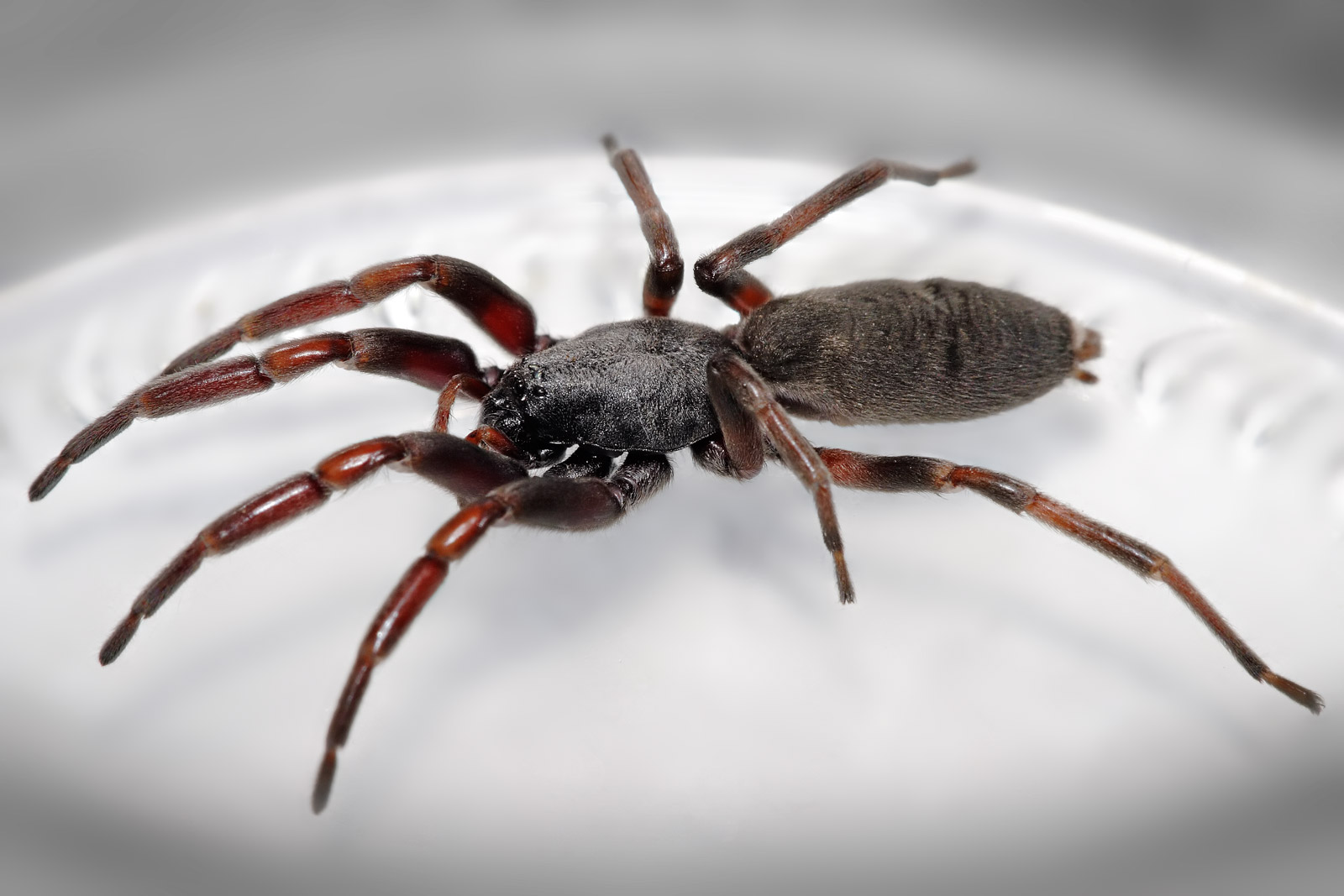Description:White-tailed (or white-tipped) spiders have a dull black, elongate body with a distinctive white spot at the end of the abdomen.
Females have a plump abdomen and grow up to 20 mm long, while males are thinner and grow to about 12 mm long.
Adult white-tailed spiders have reddish legs and two pairs of faint white spots on the top of the abdomen. Young spiders have striped legs with more distinct white spots which fade with age.
White-tailed spiders are found in southern Australia including Tasmania. Their commonly found in homes and buildings, although their natural habitat is under rocks, timber from the fallen trees and bark in gardens and bushland.
White-tailed spiders mature in summer. They do not live in a web but wander slowly in search of prey, which mostly consists of other spiders.
During the day they seek dark places to hide before emerging at night to feed.
White-tailed spiders lay eggs in a silken brood chamber placed in a dark, sheltered place. The females guard their eggs until the spiderlings hatch.
Spiderlings disperse on foot and hunt tiny prey independently.
They are found in southern Australia including Tasmania.
White-tailed spiders belong to the Lamponidae. Family/Tribe
Family/Tribe
White-tailed spiders are medium-sized spiders native to southern and eastern Australia, and so named because of the whitish tips at the end of their abdomens. Common species are Lampona cylindrata and Lampona murina. Both these species have been introduced to New Zealand.
White-tailed spiders are vagrant hunters who seek out prey rather than spinning a web to capture it. Their preferred prey is other spiders and they are equipped with venom for hunting.
They are known to bite humans and effects may include local pain, a red mark, local swelling and itchiness; rarely nausea, vomiting, malaise or headache may occur. Ulcers And necrosis have been attributed to the bites, but a scientific study by Isbister and Gray (2003) showed these were probably caused by something else, as the study of 130 white-tailed spider bites found no necrotic ulcers or confirmed infections.
New Zealand Herald
Hot weather brings pests who like to lurk in moist areas, such as wash houses and bathrooms.
White tail spiders come out in search of food during warm summer weather, and their numbers are up, according to some pest controllers.
White tails, which can inflict a painful bite, top the list of pests homeowners want eradicated.
As soon as the temperature topped 25C, the phone started ringing, said Gisborne's Stomp Em Out Pest Control owner James Guyton.
The amount of white tails had been worse this summer and there were a lot of children being bitten, he said.
"There were only one or two children that I came across last year but this year there have been about nine or 10, and quite a few adults.
"Last year, it wasn't often we went over 24 degrees but this year we are into 28 and 29-degree temperatures, and the hotter the weather, the more prolific the white tails."
Mr Guyton said bedrooms, wash houses and bathrooms seemed to be the main places white tails liked to lurk.
"They like the moist areas."
Osbornes Bugs Eastland owner-operator Eamon Osborne had also noticed an increase in demand for white tail extermination services.
"They're a hot climate insect and the warmer weather makes the numbers increase.
"Last year, it was German cockroaches and white tails, but this year it is just the white tails."
Kurt Loklindt, of Target Pest Control in Christchurch, said he had also had the usual increase in white tail spider jobs this summer.
"What normally happens this time of year is because it's warmer the spiders come out of hibernation and end up going through doors and windows to feed on other spiders in the voids. They end up in people's houses and people end up getting bitten quite a bit more."
He'd had 10 to 20 spider jobs a week this summer, with about 80 per cent being for whitetails.
Chris Crean, from Buzzz Off Pest Management in Auckland, said he was receiving upwards of 10 jobs a week involving white tails, about the same as previous summers.
"Everybody's got windows and doors open this time of year so there's more seen around," he said.
The National Poisons Centre said the number of reported white tail spider bites had remained about the same over the past six years.
In the period from January 2011 to December last year, the centre received 117 inquiries about unidentified spider bites and 37 calls involving white tail spiders where the caller was able to identify the species.
John Fountain, a medical toxicologist at the centre, said there was a misconception about whitetails.
"There's been a lot of myth put out that a bite can lead to very nasty ulcers and skin lesions et cetera. This is not actually the reality.
"We hear from a lot of people who believe they've been bitten by a white tail spider because they've got some sort of painful area that's developed and they attribute that to a spider when, in fact, that's highly unlikely."
The centre received the highest number of calls about white tail spider bites following media reports on the subject, he said.
What do white tail spiders look like?
Dark grey spiders are 12-17mm long and readily recognised by a distinctive white patch on the end of the abdomen.
Are their bites dangerous?Yes its bites are really dangerous it can cause swelling and puffed bites.
According to the Ministry of Health, most white tail spider bites are harmless but occasionally a severe reaction may result in a deep ulcer.
What should you do if bitten?
It is better to see a doctor soon after the bite. To relieve stinging and swelling use ice or apply an anti-sting ointment.
Additional reporting: Sophie Rish-worth of the Gisborne Herald
